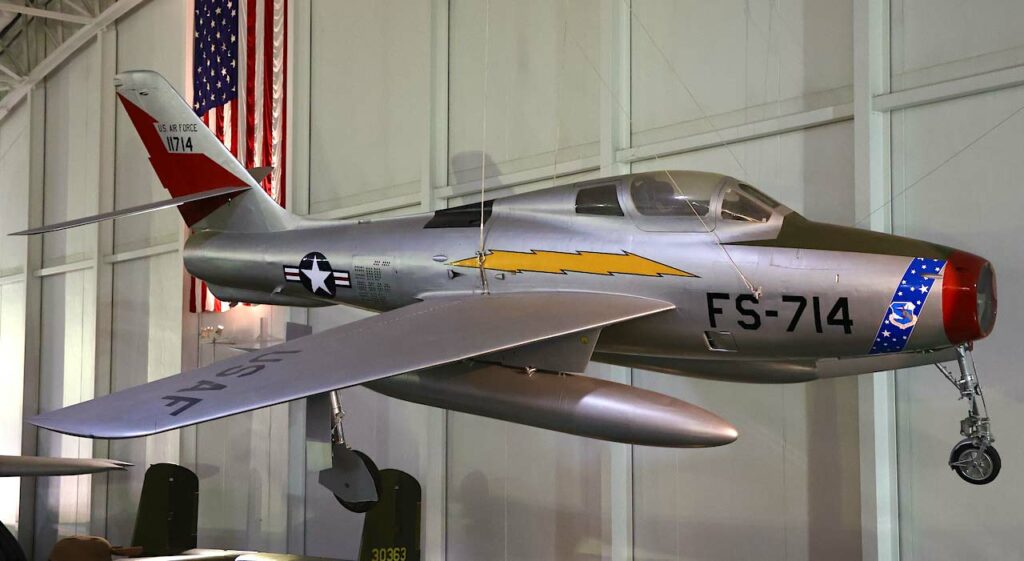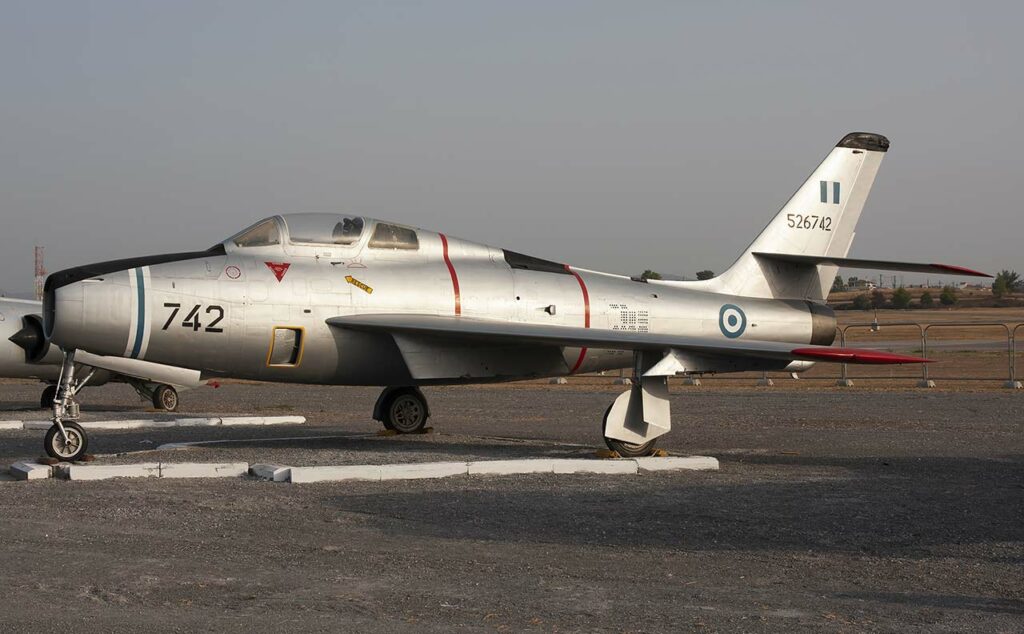F-84 Thunderstreak is a versatile fighter-bomber, symbolizing post-WWII USAF progress.
In brief
The Republic F-84 Thunderstreak, a versatile fighter-bomber, marked a significant milestone in the post-World War II aviation era. Developed in response to emerging Cold War demands, it became a cornerstone of the United States Air Force’s (USAF) arsenal. The Thunderstreak was known for its powerful engine, impressive speed, and adaptable design. This article explores the development, design, performance, variants, military use, and combat history of this iconic aircraft, shedding light on its role in pivotal conflicts like the Korean War. From its maiden flight in 1946 to its eventual retirement, the F-84 Thunderstreak played a vital role in shaping modern air warfare.
The Republic F-84 Thunderstreak emerged during the tense post-World War II period when the world was divided into two opposing blocs, the Western Allies led by the United States and the Eastern Bloc dominated by the Soviet Union. The need for advanced aircraft that could respond quickly to evolving threats and carry out multiple roles was paramount. Thus, the development of the F-84 Thunderstreak was initiated to bolster the capabilities of the United States Air Force (USAF).

History of the Development of the Republic F-84 Thunderstreak
In the late 1940s, as tensions between the United States and the Soviet Union escalated, there was a pressing need for a new generation of fighter-bombers capable of delivering both nuclear and conventional payloads. In response, the USAF initiated a program to develop a versatile aircraft that could fulfill these requirements. The Republic Aviation Corporation took on the challenge and introduced the F-84 Thunderstreak.
The F-84 Thunderstreak’s development began in 1944, led by Republic Aviation’s brilliant engineer, Alexander Kartveli. The primary objective was to create an aircraft that could effectively replace the aging P-47 Thunderbolt and P-51 Mustang. The Thunderstreak was envisioned as a high-speed, single-seat fighter-bomber with the capability to carry a nuclear bomb, aligning it with the evolving Cold War strategy.
On February 28, 1946, the prototype XF-84 Thunderstreak took to the skies for the first time, marking the beginning of its flight-testing phase. This early version featured a straight wing design and was powered by an Allison J35-A-25 turbojet engine.
The Thunderstreak’s NATO nickname, “Thunderstreak,” reflected its lineage from the P-47 Thunderbolt and its incredible speed and maneuverability. It embodied the United States’ commitment to maintaining air superiority and nuclear deterrence during the early years of the Cold War.
As the aircraft evolved, the straight wing was replaced with a swept-wing design, enhancing its speed and stability. The F-84G Thunderstreak, equipped with the General Electric J47 engine, became the most iconic variant and saw extensive use during the Korean War.
Design of the Republic F-84 Thunderstreak
The Republic F-84 Thunderstreak was a robust and versatile aircraft designed to excel in multiple roles. It featured a sleek and aerodynamic design, with swept wings that improved its high-speed performance and stability.
With a length of 38 feet (11.6 meters), a wingspan of 33 feet (10 meters), and a height of 12 feet (3.7 meters), the Thunderstreak had a compact yet powerful profile. Its empty weight was approximately 11,000 pounds (5,000 kg), while its maximum takeoff weight reached 21,000 pounds (9,500 kg).
One of the Thunderstreak’s standout features was its General Electric J47-GE-17 turbojet engine, generating up to 6,000 pounds of thrust. This powerplant propelled the aircraft to a maximum speed of 695 miles per hour (1,118 kilometers per hour), making it one of the fastest aircraft of its time.
Despite its impressive speed, the F-84 Thunderstreak had some drawbacks. Its range was limited, with a combat radius of approximately 400 miles (644 kilometers). This necessitated frequent refueling during long missions. Additionally, its cockpit design was somewhat cramped, which could be uncomfortable for pilots during extended flights.
The Thunderstreak’s armament was centered around its capacity to carry various combinations of bombs, rockets, and air-to-air munitions. It was equipped with six 0.50 caliber Browning M3 machine guns, offering substantial strafing capabilities. Additionally, it could carry up to 6,000 pounds (2,722 kilograms) of ordnance, making it a formidable ground attack aircraft.
The F-84 Thunderstreak brought versatility and adaptability to the USAF’s arsenal, allowing it to serve both as a fighter and a bomber. Its swept-wing design and powerful engine set the stage for its exceptional performance in the years to come.
Performance of the Republic F-84 Thunderstreak
The Republic F-84 Thunderstreak boasted exceptional performance capabilities, driven by its powerful General Electric J47-GE-17 turbojet engine. This engine provided the aircraft with an impressive 6,000 pounds of thrust, catapulting it to a maximum speed of 695 miles per hour (1,118 kilometers per hour) at sea level.
In terms of altitude, the F-84 Thunderstreak could reach a maximum height of 45,000 feet (13,716 meters), allowing it to operate effectively in a variety of combat scenarios. Its climb rate of 6,000 feet per minute (1,829 meters per minute) ensured rapid response to aerial threats or the ability to quickly gain altitude for strategic bombing runs.
The Thunderstreak’s combat radius, while limited, was approximately 400 miles (644 kilometers). This range allowed for missions that required relatively short distances, such as air-to-air combat or close air support.
Compared to its contemporaries, the F-84 Thunderstreak stood out as a powerful and fast aircraft. Its speed and agility were key advantages, particularly during the Korean War, where it often outperformed its adversaries, including Soviet-made MiG-15s. The Thunderstreak’s adaptability as a fighter-bomber made it a versatile asset in both air-to-air combat and ground attack missions.
Variants of the Republic F-84 Thunderstreak
The Republic F-84 Thunderstreak underwent several variants during its service life. These included the F-84A, F-84B, F-84C, F-84D, and the F-84E, each with incremental improvements in design and performance. The F-84G Thunderstreak, equipped with the powerful General Electric J47 engine, became the most notable and widely used variant.

Military Use and Combat of the Republic F-84 Thunderstreak
The Republic F-84 Thunderstreak was a prominent figure in various conflicts, most notably during the Korean War. Its armament consisted of six 0.50 caliber Browning M3 machine guns, which provided formidable strafing capabilities, along with the ability to carry up to 6,000 pounds of bombs or rockets.
In the Korean War, the Thunderstreak played a crucial role in defending South Korea from North Korean and Chinese forces. It conducted numerous missions, including combat air patrols, ground attack sorties, and interdiction missions. One of its primary roles was providing close air support to ground troops, helping to repel enemy advances.
During the conflict, the F-84 Thunderstreak faced off against the Soviet-made MiG-15, one of the most formidable opponents of its time. While the MiG-15 was a worthy adversary, the Thunderstreak’s superior speed and firepower often allowed it to hold its own in dogfights. Its adaptability as a fighter-bomber made it a valuable asset for multi-role missions.
The F-84 Thunderstreak also served in the hands of other NATO countries, contributing to the defense of Western Europe during the early years of the Cold War. Its presence bolstered the alliance’s capabilities and demonstrated the United States’ commitment to collective security.
Over time, as technology advanced and newer aircraft became available, the F-84 Thunderstreak was gradually phased out of active service. It was replaced by more modern jet fighters, such as the North American F-100 Super Sabre and the Republic F-105 Thunderchief.
The Republic F-84 Thunderstreak, born in the early years of the Cold War, represented a significant leap forward in aviation technology. Its remarkable speed, versatility, and adaptability made it a valuable asset in various conflicts, notably the Korean War. While retired from active service, the Thunderstreak’s legacy endures as a testament to its pivotal role in shaping modern air warfare and the defense strategies of its era.
Back to the Fighter Jet section.